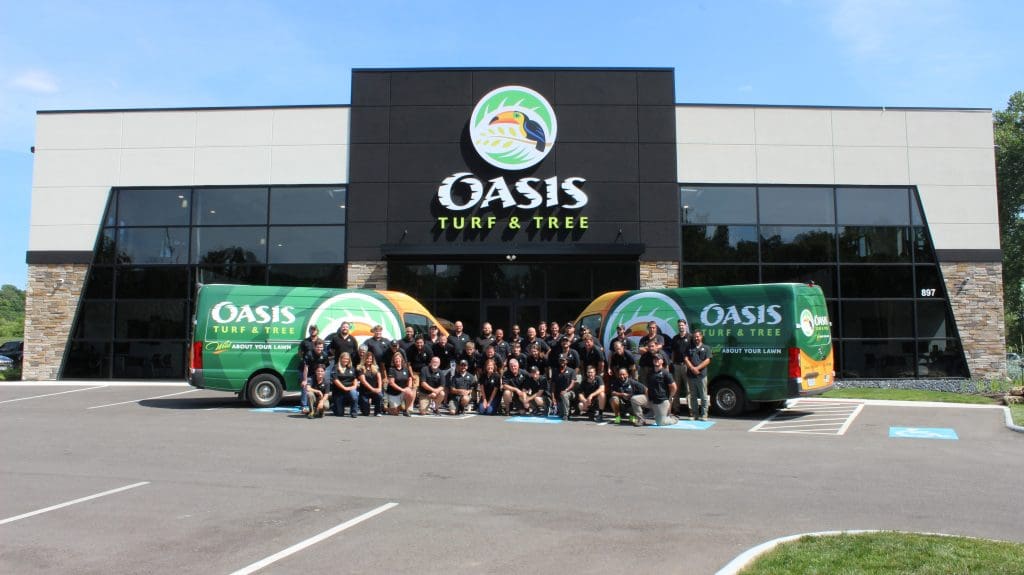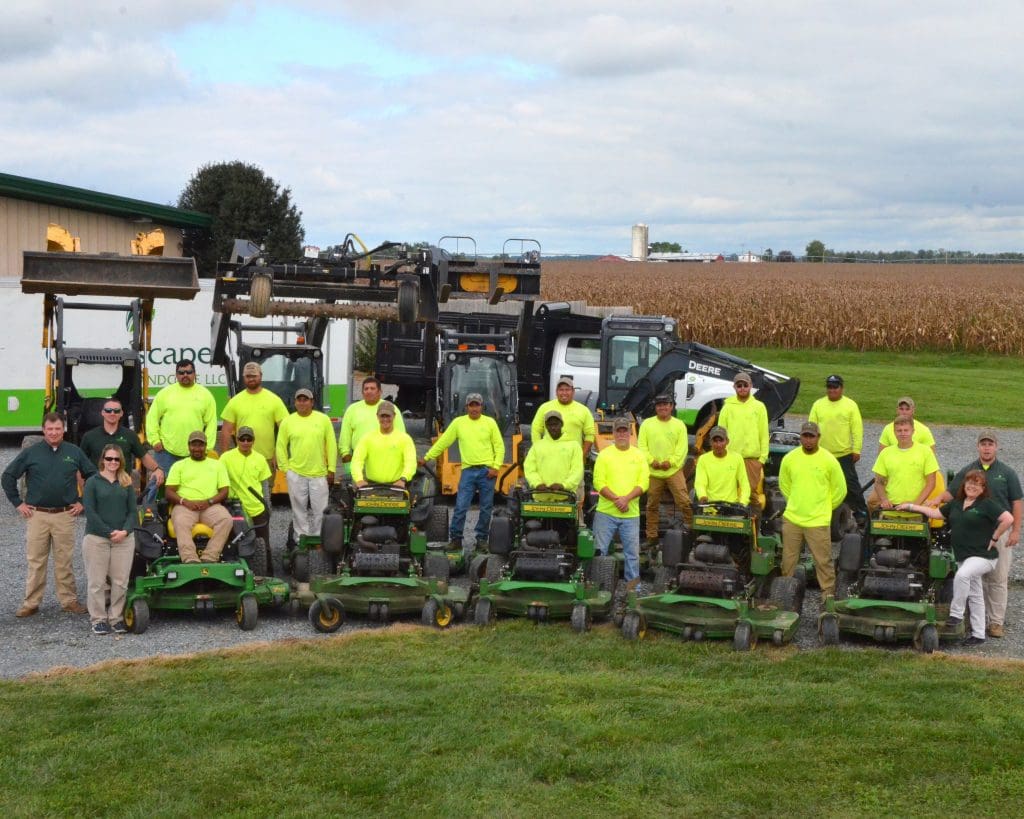
Have you thought about how to grow your business? Is there a right way to go about growth? Considering this is one of the most-searched-for business topics on the internet — and entire books are dedicated to it — there’s no simple answer. But we’re diving into the services and strategies used by some successful industry businesses to find out what it took them to grow. Every company’s growth story is a little bit different and what’s right for your business may not be right for another. But it can still help to glean some ideas from other companies that have seen success in growth.
Growth by Addition
Probably the most expected growth narrative is that companies will grow by adding services and people. That was the case for Casey Hurd, LIC, owner of Worton, Maryland-based Greenscapes Land Care, LLC, who says that over the years, they’ve added services in order to become more of a full-service landscaping company that wouldn’t cause their clients to have to ever look elsewhere. Hurd says that he has grown the company by adding services, employees, and equipment.

Photo: Joshua Tree
“The biggest step that we took to grow the company was to add employees that would help manage the challenges that we face daily,” Hurd says. “As I had the people to support the services, I also added services so that we had to stop subbing out work. We have also invested in new and high-quality equipment to support the work. We have found that avoiding breakdowns and getting higher quality results is worth the higher equipment cost.”
Joshua Malik, owner of Joshua Tree in Stockertown, Pennsylvania, is also a good example of growing a business by adding services. Every addition has been slow and deliberate. Malik says that he knew jumping into a service without thoughtful planning could be problematic.
The company got its start in 2005 as an arborist firm but began adding lawn care services in 2013 in response to demand. At the time, Malik says he was only cross selling those offerings to current clients and not marketing them at all. He had a loyal customer base who wanted Joshua Tree to handle more on their properties. In 2017, the company only had 250 lawn care contracts but decided they wanted to ramp up marketing and set Joshua Tree up as a serious lawn care provider in the area. That year, Joshua Tree partnered with marketing agency Landscape Leadership to develop a strategy and has grown the business to 2,500 customers today.
At the start of 2020, that story repeated itself when — after a lot of demand and a lot of contemplation — Malik decided to expand into pest control. Of the 400-plus pest control clients the company has already accrued, 78 percent already used Joshua Tree for other services.
A number of lawn and landscape businesses have expanded into pest control and Malik says he knew he was not only competing against them but against exterminators in the area. That was why he decided to make his division model a bit difference.
“A lot of lawn care companies are offering perimeter pest control and focusing on outdoor treatments,” Malik says. “But we wanted to differentiate ourselves so that our clients didn’t feel as though they needed to still hire an exterminator for indoor pest problems. But in order to do that successfully, we needed to bring on the right person.”
Malik hired a pest control specialist who had been working in the pest control industry for more than 15 years to oversee the division. The quarterly pest control services include three exterior visits and one interior visit — a key differentiator.
It’s a good example of how creating a division thoughtfully, and putting the right people in place, can support its growth.
“Brian was here before the first piece of marketing ever went live,” Malik says. “You need people, first. Get someone who knows what they’re doing and then start building from there. It’s an investment in your business.”
Growth by Subtraction
Although it might seem to buck the trend, sometimes growth also means subtracting services. That was the case for Oasis Turf & Tree, headquartered in Loveland, Ohio. Rob Reindl, LIC, says that he founded the company as a full-service landscape maintenance firm — but ultimately made the decision to narrow their focus to lawn care. He says his reasoning had to do with a fear of being a “jack of all trades, master of none.”

Photo: Oasis Turf & Tree
Even so, Reindl says he doesn’t regret starting as a full-service business.
“Had I started as just a lawn care company, I never would have known that we didn’t want to grow into those other things that we had started out doing,” he says. “It’s more valuable to learn from your experiences.”
Reindl says that he’s continued to grow the company by keeping the focus narrowed and perfecting the work that they do. He says their strong focus on training and education has allowed them to charge more.
“I have always believed that if we do a better job than everyone else then we can charge more for our services and ultimately pay our people better,” Reindl says. “I realized that if we honed in on lawn care that we could provide a much better career opportunity for our people by focusing on becoming the best at what we do. It’s a more specialized type of work and it justifies higher earnings.”
Adam Zellner, vice president of sales for the company says that the question has always been, “What can we do to give our customers the best experience and the best service even though we’re solely focused on lawn care?”
The answer has been a laser focus on training so that team members are better at the services they provide. That has included encouragement and support for team members to become Landscape Industry Certified through NALP. Zellner says that there are company pay raises associated with earning this certification and others. Whereas other companies might be nervous about losing employees if they become better-trained — and ultimately more qualified — Oasis has been fostering a positive work culture and paying their people better, so that they ultimately want to stay.
“All of this continues to give our customers a better experience — and that’s what has helped us grow,” Zellner adds. “Despite all of the investment that we make into marketing and advertising, our number one source of leads still comes from referrals and that’s a testament to the fact that we’re continually focused on that customer experience.”
There’s no question it shows in the company’s numbers, as well. Oasis Turf & Tree went from a $2.2 million company in 2012 to the $8.4 million company it is today. And they continued to see growth this year, despite the pandemic.
“I think our growth this season has had a lot to do with the fact that we stayed the course,” Zellner says. “We had plans in place including investments in marketing and we didn’t let up on those plans even when the shutdowns began. I would say that definitely helped us.”
Though the pandemic has certainly left some companies unsure of future growth, Reindl adds that people spending more time at home could ultimately be a good thing for our industry. As more homeowners are staring at their lawns — and their backyards in general — there just may be opportunities to capitalize on growth.
“I’m hopeful that the trend of people spending more time at home will continue to inspire them to invest in their properties,” Reindl says.
Investing in People
If there’s a common thread in these stories, it’s the idea that investing in people is one of the best growth strategies out there. Whether you add or subtract services, having the right people on board means everything.

Joshua Pool, LIC, chief operations officer of Timberline Landscaping in Colorado Springs, Colorado, says that investing in people means looking at not only your hiring strategy but your retention one, too. If you have great employees — focus on what it will take to keep them.
“We’re also really focused on recruiting young people and getting kids interested in landscaping again,” Pool adds. “If we’re going to solve this industry’s labor challenge, it’s going to come down to inspiring interest from the younger generations.”
In the past, Pool says that Timberline has always relied heavily on the H-2B program. But the uncertainty of that program in recent years has meant looking at other avenues. That has translated to more involvement in NALP’s National Collegiate Landscape Competition (NCLC) and also getting more involved in local high schools.
“I think it’s important for high school students to know that they don’t always have to go to college to have a successful career,” Pool says. “Showing high school kids that landscaping can be a viable career path is really important for our industry as a whole.”
In terms of investing in people, Pool says that a big part of that has been the fact that they prefer not to lay their people off during the off-season. In order to be able to keep team members on board year-round, and prevent the risk of ultimately losing them, the company added a Christmas Décor franchise back in 2002 — and recently won Veteran Franchise of the Year for their success. Pool says that the idea is to keep employees busy — and employed.
“We have weird weather in that when it does snow, it’s usually gone quickly, so we try to keep our construction division going, too,” Pool says. “Between that and the Christmas Décor franchise work, we’re able to keep most of our key employees working.”
Oasis Turf & Tree also believes in employing their team in the off-season and typically uses this time to complete some of the training that they might not have time for during the busy season.
“That’s the ideal time we can train on customer service, equipment, agronomics, and support them in working toward new certifications,” Zellner says.
Parting Words of Wisdom
The companies that we spoke to about their growth all echoed a similar sentiment that there’s no “one way” that works for everyone. At the end of the day, whether it’s adding services — or perhaps becoming more specialized — you have to find what works best for your business.
Greenscape’s Hurd says that can admittedly be difficult to do when you’re wrapped up in the business. For that reason, it often really helps to find a mentor or someone who can offer an outsider’s perspective.

“My best advice for a company that wants to grow is to find a mentor, ideally within the landscape industry, who can offer you advice and guidance,” he says. “I’ve had quite a few mentors over the years, both locally and nationally, that have helped me get to where I am today. They’ve opened my eyes to things I couldn’t see because I was too close to it all. Being involved in the NALP has always helped open my eyes to what’s happening on a national level — to see what other companies are doing.”
Hurd also says to surround yourself with professionals from outside of the industry. Ultimately, you need a team of people to support your business who aren’t on the payroll — but whose services are just as important.
“It’s important that young companies start to build good relationships with bankers, insurance agents, attorneys, and accountants,” Hurd says. “Finding the right people will help you move forward. I can honestly say I wouldn’t be where I was today had I not found the right people behind-the-scenes that helped support our growth.”
Pool adds that building relationships with other companies — just outside the scope of the green industry — has also helped Timberline to grow.
“Over the years we’ve built really great partnerships with concrete companies or fencing companies — basically companies that offer services we don’t really want to get into but that are often considered part of a package for a large landscape project,” he explains. “That makes us a turnkey solution.”
Reindl offers a few parting words of wisdom for companies who are working for growth — saying not to lose sight of what made you reach that point in the first place. For strong, organic growth, it’s more likely great customer service.
“Quality results and customer experience are two big things that will separate you from the competition and you can’t let them drop just because you’re growing,” he says. “If you’re willing to invest in that growth — and, more specifically, in your people — then the growth will come. You just have to be ready to support it.”
Pool says that it really does boil down to that customer experience if you want to keep growing your business. At the end of the day, people have to be happy and want to keep hiring you — or referring your work to others.
“There’s no secret sauce,” Pool says. “It really does come down to great customer service in the end. You have to have well-trained people who do really great work — and you can’t let that slip just because you’re growing. It means constantly looking at how you can maintain the good things you’re doing and make improvements where they’re needed. Plus, it means constantly evaluating and never becoming complacent. All of that adds up to smart growth.”
Want to learn more about how to substantially grow your company? Attend the “Focus on Growth: How to Substantially Grow Your Company” panel discussion at LANDSCAPES 2020: The Virtual Experience on Tuesday, Oct. 20 at 1:00-2:15 p.m.
This article was published in the Sept/Oct issue of the magazine.

